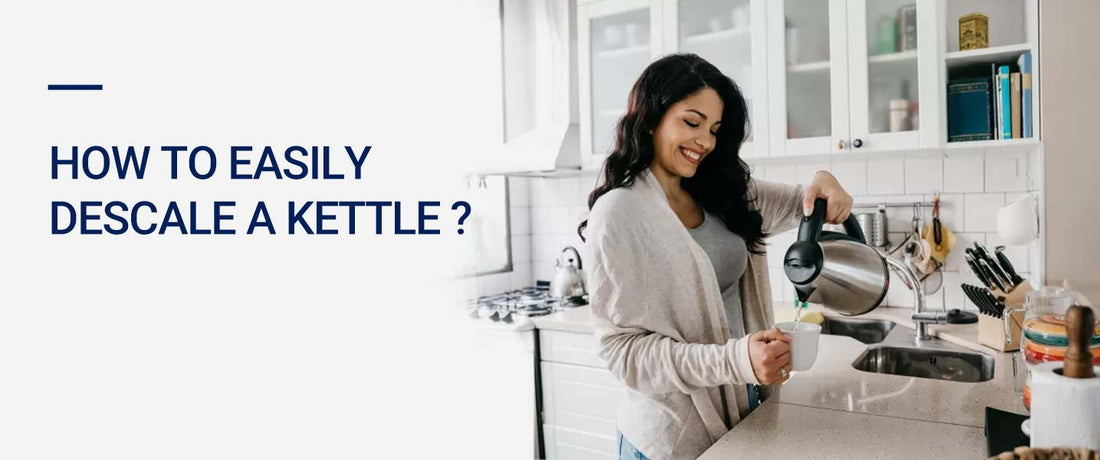Limescale is a major problem for homeowners in Ireland. Almost all kitchen appliances are affected, but kettles are particularly prone to getting clogged up with chalky scales and need regular cleaning so they continue to work efficiently – and to ensure you don’t get unwelcome chalky white deposits floating in your next cup of tea. Not only is limescale detrimental to your tea or coffee-drinking experience, but if left too long, it can also shorten the lifespan of your best kettle and no one wants that. That’s why we believe everyone should know how to descale the kettle. To ensure a nice brew never goes to waste! In this blog, we discuss easy ways to solve the limescale problem in kettles and prolong their lifespan.
What is Limescale and How Does It Build Up in Kettle?
Limescale (calcium carbonate) is a white, chalky, and tough deposit that clogs up the filaments of your kettle and forms when hot water has evaporated and solidified. It is very common in hard water areas. Now, what is hard water you might ask? Hard water is water containing an excessive amount of minerals such as calcium and magnesium. It’s a natural result of minerals accumulating during the water cycle, and it can happen with well water and even city water. The more calcium and magnesium dissolved in the water, the harder the water becomes. Once the water is heated, the minerals are left behind, and that’s how limescale gets into your kettle. While limescale is not dangerous, it can change the taste of your water and can end up floating in your water, causing damage to your kettle or end up in your drink. It will also shorten the lifespan of your kettle, slowly eroding the inside of your kettle.
How Often Should You Consider Descaling Your Kettle?
You should be descaling every four to eight weeks to keep your kettle clean - don't let scale build-up, as it's more difficult to remove the longer it's there. Heavy deposits might need a repeat treatment to completely break them down. If you live in a hard water area such as Dublin, Meath and nearby areas, then you really ought to descale your kettle about once a month: the more you let limescale build-up, the harder it becomes to remove. However, if you are in a soft water area, with low concentrations of calcium and magnesium, you may be able to get away with descaling much less frequently, or not at all.
How to Descale a Kettle?
Now that you’ve understood why limescale builds up in your kettle, you can start removing it. Limescale in kettles can be removed by using everyday products easily found in most kitchens.
Vinegar
- Fill the kettle up to half capacity with a solution of equal parts water and white vinegar.
- Bring the kettle to a boil and then turn it off (if it doesn’t do so automatically) and allow the mixture to stay in the kettle for up to 30 minutes.
- Pour away the liquid after use, rinse out the kettle with fresh water.
- Boil the kettle once or twice at full capacity to make sure that there is no lingering taste of vinegar.
Lemon Juice
Lemon is high in citric acid, making it a powerful cleaning agent, ideal for kettles that have seen better days.
- Fill the kettle half full with lemon juice. You can pick up a bottle in the cleaning aisle.
- Fill the rest of the kettle up with water.
- Boil it and let it sit for 30 minutes until the limescale starts to dislodge.
- Pour out the lemon and water, and rinse.
Soda
Your favourite carbonated drink has a phosphoric acidity at a pH level of 2.8, which makes it as effective as lemon juice or vinegar for some cleaning tasks.
- Pour enough Cola into your kettle to fill it and then set it to boil.
- After it has boiled, leave it to cool down for about 45 minutes before pouring it out.
- Thoroughly wash and rinse out your kettle afterwards and boil some fresh water in it, discard it and then you’ll be ready to make a cup of tea again.
How to Prevent Limescale from Coming Back?
To keep your kettle clean from limescale, empty it after each use. You will promote limescale build-up even more if the water sits inside overnight before you need to use the kettle again in the morning. And think! Wouldn’t your tea taste better if you made it with fresh water? To avoid wasting water, try and only fill your kettle with the amount of water you need, whether you're making tea or cooking pasta.
Kettle Limescale can be a Sign of a Bigger Problem
Hard water is not only detrimental to your kettle but also wreaks havoc in your home. Hard water, over time, can lead to inconvenient and costly problems like:
- Limescale deposits on taps, appliances, sinks, and shower screens.
- Higher energy bills because water appliances work harder.
- Short lifespan of appliances which may lead to expensive repairs/replacements.
- Reduced pressure in taps due to clogged pipes
- Itchiness and dryness of skin & hair
- Faded & dull laundry
Eliminating limescale from home requires preventative measures. Installing a water softener removes the hardness-causing minerals at the source and prevents them from entering your water in the first place. The best thing about these is they not only help your appliances but also, remove existing limescale in the pipework built over the years. Celtic Water Solutions has helped thousands of customers improve water quality in their homes, banish limescale and save almost €600 annually.
Explore the many benefits of a water softener.

